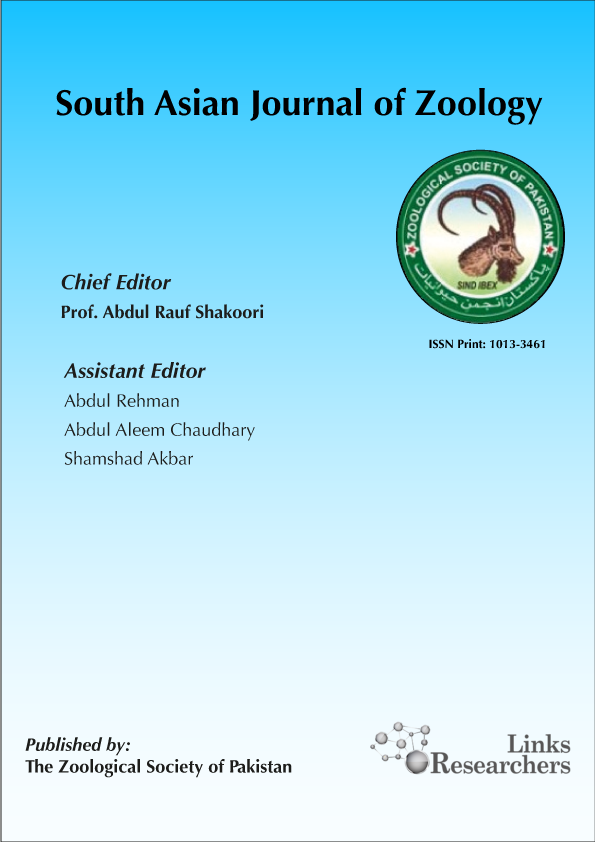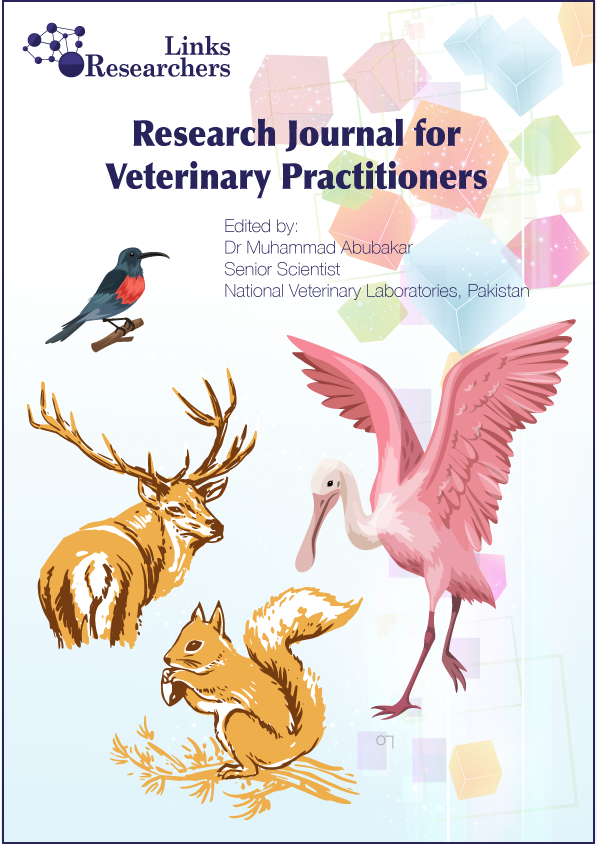Simon Mwangi Kihu1*, George Chege Gitao1, Lily Caroline Bebora1, Njenga Munene John1, Gidraph Gachunga Wairire2, Ndichu Maingi1, Raphael Githaiga Wahome1, Davis Njuguna Karanja1, Julius Otieno Oyugi3, Ernest Lutomia3
Gerald Misinzo1,*, Tebogo Kgotlele1, Epaphras A. Muse1, Jan Van Doorsselaere2, Mikael Berg3, and Muhammad Munir4
Rodolfo Villagra-Blanco1*, Gaby Dolz1, Danilo Montero-Caballero2, Juan Jose Romero-Zuniga2
Ashley C. Banyard1* and Satya Parida2
Vinayagamurthy Balamurugan*, Gurrappa Naidu Govindaraj and Habibur Rahman
Moustafa Kardjadj1, Pam Dachung Luka2
Gurrappa Naidu Govindaraj, Vinayagamurthy Balamurugan*, Habibur Rahman
Ahmed Zein Mahmoud1, Muaz Abdellatif 2, 3*, Luai Shazali1
Amitha Reena Gomes1, Belamaranahally Muniveerappa Veeregowda2, Sonnahallipura Munivenkatappa Byregowda1, Vinayagamurthy Balamurugan3*
Klara Fischer1*, Erika Chenais1,2, Emeli Torsson1, Jonas Johansson Wensman1
Mohammad Mushfiqur Rahman1, Rokshana Parvin1, Ataur Rahman Bhuiyan1, Mohammad Giasuddin2, Shah Md. Ziqrul Haq Chowdhury3, Mohammad Rafiqul Islam1, Emdadul Haque Chowdhury1*
Muhammad Abubakar1*, Shumaila Manzoor2, Jonas Johansson Wensman3, Emeli Torsson3, Qurban Ali1 and Muhammad Munir4
Hassan Tarik Atmaca
Jose M. Rojas, Noemi Sevilla and Veronica Martin
Aziz-ul-Rahman, Farooq Yousaf, Naveed Anwar and Muhammad Abubakar
Ahmed Zein Mahmoud, Muaz Abdellatif and Ahmed Abdalla
Hussein Aly Hussein1*, Omneya Mohamed Khattab2, Shereen Mohamed Aly2, and Mohammed Abdel Mohsen Rohaim1
Ahmed Zein Elabdeen Mahmoud1, Muaz Magzob Abdellatif2* and Mohamed Abdelsalam Abdalla3
Maimoona Bashir*, Imtiaz Ahmad Qamar*, Muhammad Fateh Ullah Khan* and Raheel Babar*
Ghazala Nawaz*, Muhammad Nawaz Malik**, Muhammad Hassan
Mushtaq***, Fraz Munir Ahmad****, Ali Abdullah Shah*****, Farooq
Iqbal******, Shinawar Waseem Ali*******, Zahida Fatima******** and
Amjad Khan*********
Ahmed Zein Elabdeen Mahmoud1, Muaz Magzob Abdellatif2* and Mohamed Abdelsalam Abdalla3
Shaista Naz1*, Noor Paio Khan1, Naveed Afsar2 and Ashfaq Ahmad Shah3
Saira Zaheer1, Abrar Hussain1*, Aqsa Khalil1, Muhammad Mansha1, Muhammad Lateef2
Rafiullah1*, Abdur Rahman2, Khalid Khan1, Anwar Ali1, Arifullah Khan2, Abdul Sajid3 and Naimatullah Khan3
Muhammad Usman Ghani1*, Muti Ur Rehaman Khan1, Asim Aslam1, Zubair Shabbir2, Li Bo3 and Naveed Anwar4
Abdul Razzaq1*, Muhammad Islam2, Zahra Islam3, Zahida Fatima1, Munib Hussain4 and Farmanullah5,6
Reda Mohamed1, 2
Nasrullah1*, Ahmad Nawaz Khoso1, Jamila Soomro2, Ilahi Bakhash Marghazani1, Masood-ul-Haq Kakar1, Abdul Hameed Baloch1, Sarfaraz Ahmed Brohi1 and Muhammad Asif Arain1*
M. Hammouchi1*, G. Sebbar1, N. Touil2, C. Loutfi1, Y.S. Malik3, M. El-Harrak1 and O. Fassi-Fehri4
Joseph Anejo-Okopi1*, Obinna Oragwa Arthur2, Ocheme Julius Okojokwu1, Sarah Joseph1, Geoffrey Chibueze1, Joshua Adetunji1, Joseph Ameh Okwori3, David Ochola Amanyi4, Otobo I. Ujah5 and Onyemocho Audu6
Said Sajjad Ali Shah1*, Muhammad Ilyas Khan1, Aziz Ullah1, Hayat Ullah2 and Faisal Ahmad2
Muhammad Yousif Jakhrai1, Ahmed Nawaz Tunio2, Ali Mujtaba Shah1*, Tarique Ahmed Khokhar1, Muhammad Mohsen Rahimoon1
Manar F. Seioudy1, Magda M. Sayed1, Ahmed A. El-Sanousi2 and M. A. Shalaby2
Manar F. Seioudy1, Magda M. Sayed1, Ahmed A. El-Sanousi2 and Mohammed A. Shalaby2
Yanqiang Zhou1, Lixin Wang1, Chunxiao Hao1, Xiuyun Li2, Shakeel Hussain1, Dongdong Shen1, Zhiwei Peng1, Qi`an Zhai1 and Zhijun Hou1,*
Mohammed Naji Ahmed Odhah1,2*, Dhary Alewy Almashhadany6, Abdullah Garallah Otaifah7, Bashiru Garba5, Najeeb Mohammed Salah2, Faez Firdaus Abdullah Jesse4*, Mohd Azam Khan G.K3
Sadarman1, Agung Irawan2, Muhammad Ridla3, Anuraga Jayanegara3*, Nahrowi3, Roni Ridwan4, Ahmad Sofyan5, Hendra Herdian5, I Nyoman Guna Darma5, Teguh Wahyono6, Dewi Febrina1, Rakhmad Perkasa Harahap7, Rizki Amalia Nurfitriani8, Danung Nur Adli9
Nguyen Binh Truong1,2,3*, Nguyen Van Thu3
Shireen S. Aboelwafa¹, Alsagher O. Ali², Rania Hamada³, Hassan Y.A.H. Mahmoud2*
Sadaf Shahid1, Abdul Razzaq2, Gul-Makai1, Asim Shamim3*, Hafiz Muhammad Rizwan4, Rana Hamid Ali Nisar5, Qaiser Akram6, Mohsin Nawaz3
Zein Ahmad Baihaqi1,2, Irkham Widiyono3*, Bambang Suwignyo4, Amado A. Angeles5
Bikash Puri1, Anil K. Tiwary2, Bharata Regmi3,4, Dinesh K. Singh1, Doj R. Khanal5 and Manoj K. Shah3*
Mashakgene Isaac Senoamadi, Thobela Louis, Tyasi Teedzai Chitura*
A.J. Shoyombo1, O.O. Alabi, B.M. Falana1*, R.A. Animashahun1, S.O. Olawoye1, F.A. Okenniyi1, M.A. Popoola2, C.I. Ukim2, A.M. Ake, A.E. Jubril3
Djadouni Fatima* and Meliani Amina
I Gusti Lanang Oka Cakra1*, Anak Agung Ngurah Badung Sarmuda Dinata2, I Gede Mahardika1, I Gusti Nyoman Gde Bidura1
Aiman Batool1, Muhammad Sohail Sajid1,2*, Hafiz Muhammad Rizwan3**, Asif Iqbal4, Imaad Rashid5, Ibadullah Jan6, Faiza Bano7, Fiaz Ahmad8, Waqas Ahmad1, Muhammad Nisar Khan1
Arsalan Maqbool1,2, Faez Firdaus Abdullah Jesse1,3*, Eric Lim Teik Chung3,5, Abd Wahid Haron3, Mohd Azmi Mohd Lila5, Bura Thlama Paul3,4, Khaliq ur Rehman Bhutto3,6
Nguyen Hai Quan, Nguyen Huu Van*, Nguyen Thanh Thuy, Vo Thi Minh Tam, Le Duc Thao, Le Duc Ngoan
Nishim Bhusal1, Bhuwan Raj Bhatt2*, Saroj Shrestha3 and Arjun Chapagain4
Muhammad Izhar ul Haque1, Farhan Anwar Khan1*, Umar Sadique1, Hamayun Khan1, Zia ur Rehman1, Salman Khan1, Hayatullah Khan1,2, Faisal Ahmad1,3, Mumtazur Rahman1, Faiz Ur Rehman1, Muhammad Saeed1, Mehboob Ali1 and Saqib Nawaz1
Shahid Amin1*, Jabbar Khan1, Imran Khan2, Dost Muhammad1, Kamran Ullah Khan1, Naqeeb Ullah Khan1, Muhammad Azhar Jameel3
Abdurakhim E. Kuchboev1*, Mehmonjon Kh. Egamberdiyev2
Muhammad Azam1*, Shaista Naz1*, Malik Muhammad Shafi2, Muhammad Jamil Afridi3 and Ahmad Waheed4
Majid Ali*, Hafiz Abdul Majid, Farman Ullah, Tahir waseem, Muhammad Rashid Khan
Muhammad Sohail1* , Zubair Ali1, Hamidullah1, Yasir Amin1, Mehwish Malik1, Said Sajjad Ali Shah2
Hemayet Hossain1, Md. Masud Parvej1*, Khadiza Akter Brishty3, Muhammad Ali4, Junayed Ahmed4, Asibul Hasan4, Rubel Miah4, Md. Piplu Mia4, Saad Muhammad Rafe-Ush-Shan4, Md. Nazmul Alam4 and Md. Zahidul Islam Khan2
Ovirup Bhushan Paul1, Shodipta Sharma Urmi2, Md. Ashraf Ali Biswas3*
Riswandi1*, Ali Aim1, Muhakka1, Afnur Imsya1, Agus Wijaya2
Salvator Minani1,2*, Eric Nsengiyumva1, Anatole Bigirimana1,2, Arnaud Cubahiro1,2, Dieudonné Ntakirutimana1,2 and Vénuste Bizoza1,2
Elihasridas, Mardiati Zain*, Roni Pazla, Simel Sowmen, Qurrata Aini
Mohammed Naji Odhah1,2, Faez Firdaus Abdullah Jesse1*, Bura Thlama Paul3,4, Bashiru Garba5, Zaid Mahmood1, Eric Lim Teik Chung6, Mohd Azmi Mohd Lila7
Ishtiaq Ahmed1*, Hamid Ullah2, Zubair Ali2, Muhammad Sohail2, Yasir Amin2 and Afrasyab1
Abnet Mekonnen1*, Kadir Abderehman1 and Feti Seyaka2
Abdul Latif Rind1*, Shahid Hussain Abro1, Rameez Raja Kaleri2,3, Ghulam Mustafa Solangi4, Raza Ali Mangi5, Muhammad Anees Memon6, Depeesh Kumar Bhuptani7, Sana Noor8, Zainab Lanjar9, Zahid Ali Mangrio10 and Abdul Wahid Solangi1
Sharawil , S.S.A. and Abd El-Rahim2, I.H.A.•
Ahmed Abd El Samie Hassan Ali
Laila,A. Sedeek; Fatma,S. Mohamed and Manal Abo El-Yazyed
Anak Agung Ayu Sri Trisnadewi*, I Gusti Lanang Oka Cakra
Nguyen Binh Truong1,3*, Nguyen Ba Trung1,3, Nguyen Thi Bich Hạnh2,3
Phoebe Lyndia Tolentino Llantada1,2*, Midori Umekawa2, Shuichi Karita2
Ida Indrayani*, Andi Andri, Tevina Edwin
ABRAR HUSSAIN1, AQSA KHALIL1, SAIRA ZAHEER1, MUHAMMAD LATEEF2 & MUHAMMAD MANSHA1
Ho Xuan Nghiep1,2, Nguyen Binh Truong1,2*
Anisa Mushtaq1, Murtaz ul Hasan1*, Asim Shamim2, Muhammad Ali Abdullah Shah1, Muhmamad Arif Zafar3, Abdul Asim Farooq4, Aayesha Riaz1, Muhammad Kamran1 and Saif ur Rehman1
Tianhoun Denté Fidèle1,2*, Meda Nãg-Tiéro Roland2, Zabré Geneviève3, Koama Benjamin2, Kaboré Adama1, Tamboura H. Hamidou1, Bélem Adrien Marie Gaston4
Apurbo Kumar Mondal1, Md. Rabiul Auwul2, Md. Momotaj Hossen3, Md. Sodrul Islam1*, Narayan Paudyal4, Md. Shahidul Islam1 and Kazi Khalid Ibne Khalil1
Migie Handayani1*, Dwidjono Hadi Darwanto2, Jamhari Jamhari2
Md. Nazrul Islam1*, Md. Saiful Islam Siddiqui2, Md. Rafiqul Islam3, Emdadul Haque Chowdhury3’
Ririn Siti Rahmatillah1*, Diky Ramdani1, Iman Hernaman2, Anuraga Jayanegara3, Yulianri Rizki Yanza2
Zulfiqar Ali1, Asad Ullah2*, Shumaila Gul3, Maryam Begum4, Raheela Taj5, Tahira Tayyeb1, Maiz ur Rahman1, Muhammad Owais Khan1, Rafiq Ullah1, Imad Khan2, Ali Gohar2, Shakirullah Khan6, Khudija Ghani7 and Muneeb Islam8
Muhammad Tahir1, Muhammad Saqib1, Shahbaz ul Haq2, Shahrood Ahmed Siddiqui3,4, Khurram Ashfaq1, Urfa Bin Tahir5, Mughees Aizaz Alvi1*, Shujaat Hussain6, Talha Javaid1, Raheela Taj7, Muneeb Islam8, Imad Khan9, Asad Ullah9* and Shakirullah Khan10
Hassan Ismail Musa1,3*, Latiffah Hassan1, Chandrawathani Panchadcharam2, Zunita Zakaria1, Saleha Abdul Aziz1
Mahmoud Saber1, Sabry A. Mousa2, Hisham A. Abdelrahman3, Eman Rashad4, Ramadan Sary5, Meray N. Ramsis5*

















